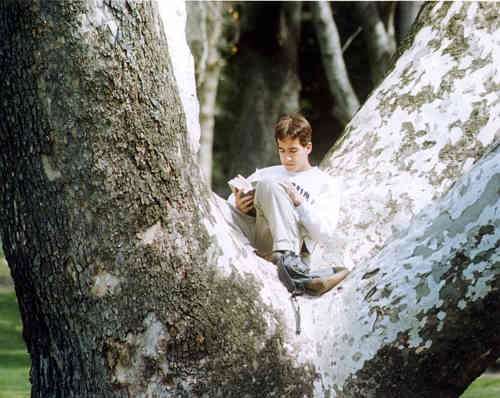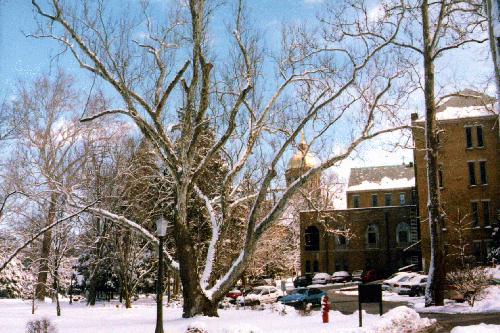
Notre Dame's Grotto / by Dorothy V. Corson


The Landmark Sycamore -- Guardian of the Grotto
Another tree on the Grotto lawn speaks in a whisper the legend it has to tell. A brief mention of it turned up on an index card in the Scholastic card catalog file. On it were the words: "Legendary Tree Stands in Rear of Corby Hall."(180) It told of a wronged Indian whose spirit had entered into the tree and formed its unusual shape.
The full story would have remained hidden were it not for the discovery of a two page account of it in an unindexed 1926 Dome. Someone had done a masterful job of documenting the legend. The two page story, illustrated with a decorative border and a small but very good picture of the sycamore, was called, "The Legend Of The Sycamore Tree."
It was not an unfamiliar story. The year before he died, Father John J. Cavanaugh, former president of Notre Dame, told the tale one day at Holy Cross House. He referred to it as "that odd-shaped sycamore that stood in back of Corby Hall near the Grotto. He said it was known as The Vengeance Tree because it had the shape of an open hand outstretched in a pleading gesture.
Father Cavanaugh was a great story teller. The fate of the "Missing Empress Eugenie Crown" was another story he told. Although many may have dismissed them as more of Father Cavanaugh's genial Irish wit -- the kind of fireside stories a beloved grandfather might spin to amuse his grandchildren -- they were such great stories about early Notre Dame, that once heard, they were never forgotten.
Was it campus lore or was there at least a kernel of truth in the legend of the sycamore? It seemed only fair to Father Cavanaugh to check this one out, too, to see if it could also be verified, most especially, because it was on the Grotto lawn, a witness to all the history that had transpired there.
Brother Vitus, oldest religious on campus at 98, had no special recollections about the huge old sycamore tree, other than the fact that it had been an impressive landmark on the campus for as long as he could remember. He said it probably dated back to the founding of the University.

The Age of the Sycamore
The tree's circumference measured an astounding 20 feet 4 inches. Taking a core sample, the only true way to age the tree, was out of the question. It was too old and too special a tree to take any risk in harming it. Instead, measurements and early photographs were sent to the Forestry Department at Purdue University for their assessment.
They affirmed its earliest age to be at least 200 to 220 years old and possibly older. "The unusual shape of the tree reflected the presence and absence of buds and growing points when the tree was very young. It was considered a happenstance of nature."(181) Most sycamores have straight trunks with branches very high up on the tree. The branches on the Notre Dame sycamore are waist high making it a most unique example of this oddity.
To arrive at an approximate 200 year age, 1794 or a bit earlier, which would have fit the legend, the tree would have to have grown from 41/2" to 5" in ten years. Literature enclosed with their letter confirmed it. The proximity to water and the excellent campus care it received would account for the unusual growth.
A Scholastic article describing the "The Walk To The Stile" provided more evidential information about the sycamore. Daniel Vincent Casey, detailed, in eloquent prose, "The Stile" (an arrangement of steps for getting over a fence or wall, while forming a barrier to the passage of sheep or cattle) and the walk which led to St. Mary's Academy. Hidden away in this article was a reference to the sycamore. He speaks of the ancient level of the lake:
Forty years ago, when that splendid old sycamore yonder was a hill-side weakling, all this basin was under water, and St. Vincent's was, in very truth 'the Island'.(182)
The article was written in 1896. The splendid old sycamore had to be the landmark tree, and 40 years ago would have been 1856. A "hill-side weakling," as compared to "that splendid old sycamore yonder," would mean it could have been up to fifty years old at the time, which would place its age somewhere near the late 1700s or early 1800s. It was more than old enough to have been on the grounds before Sorin's arrival.
The problem between the whites and the red-skins intensified throughout the Old Northwest in the late 1790s and early 1800s:
Over the next decade hostilities escalated. Wiser chiefs not only sought to keep liquor from their warriors, but blamed the Americans for their corruption. The decisive American victory at Tippecanoe in 1811 did not diminish Potawatomi hostility. Frustrated by the steady loss of Indian land, many young Potawatomis no longer followed their traditional village chiefs, who continued to cooperate with the Americans. They were well stocked with trade whiskey, and angered over the sight of white men establishing farms in an area they believed their own.
Young warriors continued to ambush and kill white settlers and the whites retaliated by burning Indian villages.(183)
There were also negotiations by the government for Indian land during the hostile period when the unfortunate incident that produced the Indian legend might have taken place:
The situation was complicated by the fact that squatters had invaded Indian lands and now demanded immediate removal. Several resulting clashes between whites and Indians seemed to confirm predictions of imminent bloodshed if something was not done soon.(184)
In 1830, Congress passed the Indian Removal Act which allowed the government to move Indians beyond the Mississippi River to make room for the settlers who were streaming westward.
Timothy Howard's History of St. Joseph County Indiana described those early Indian days in a tearful account of the Indian removal on September 4, 1838, at Menominee village at Twin lakes, five miles southwest of Plymouth, one of the "rendezvous for these foundlings of the forests."
He mentions that 67 years later, on February 3, 1905, a bill (185) was proposed to authorize the erection of a monument to preserve the memory of the Potawatomi and Miami Indians, to mark the dawn of civilization in northern Indiana and rebuild the first house of Christian worship in the entire great northwest, east of the Pacific Coast (Badin's Indian chapel at Menominee village).
Representative Daniel McDonald concluded his stirring 1905 address with these words:
The Potawatomi Indians will not be forgotten. Their memory has been preserved . . . in the rivers, lakes and various localities bearing their names. Aubenaube and Kewanna, and Tiosa, in Fulton county, and the beautiful Tippecanoe, with its rippling waters of blue; and the picturesque Manitou, and the lovely Maxinkuckee, the St. Joseph, and especially the famous Wabash.
All these names will perpetuate for all time to come the memory of the Potawatomi Indians, the first owners and inhabitants of all the beautiful country north of the Wabash river and south of the great lakes.

|
The Indians all have passed away, That noble race and brave, Their light canoes have vanished From off the crested wave. Amid the forest where they roamed There rings no hunter's shout -- But their name is on your waters -- You can not wash it out. -- Lydia H. Sigourney(186) |
Though most of the Indians were sent to Kansas, there were a few exceptions made for the Pokagon band of Potawatomi Indians who had become Christians during earlier times when Jesuit priests first came as missionaries. Even after 1838, there were still Potawatomi Indians in the vicinity. Sorin mentions that 200 Indians were in the area when he arrived in 1842.(187)
Although the Potawatomis had ceded all tribal lands in Michigan, [1837] many Indians held individual reservations, and other tribesmen still wandered through the Saint Joseph Valley."(188)